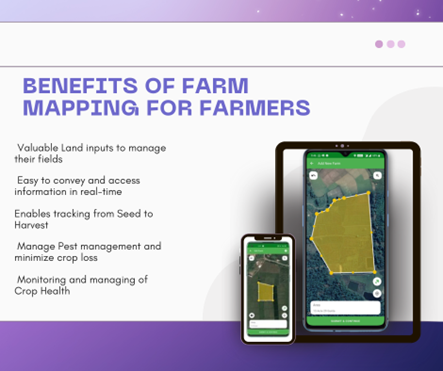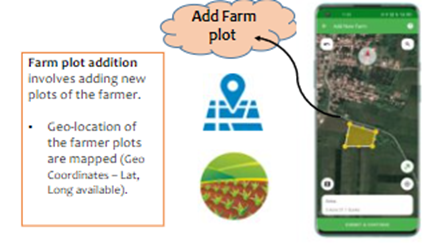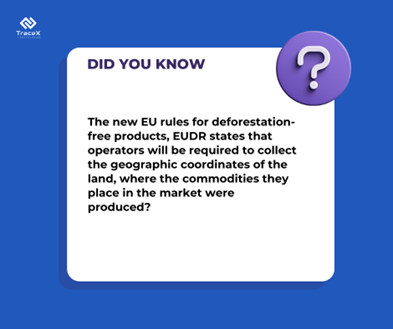Contact: +91 99725 24322 |
Menu
Menu
Quick summary: Explore the world of geospatial mapping with TraceX solutions. Unlock the potential of precise and data-driven farm management through advanced geospatial technology. Maximize efficiency, optimize resource allocation, and make informed decisions for your agricultural operations. Read our blog to learn more

Unlock the power of precision in agriculture with TraceX farm mapping solutions. By digitally mapping farm landscapes, TraceX offers farmers and agricultural stakeholders unprecedented insights into their land, crops, and operations.
From optimizing planting patterns to efficiently managing resources, TraceX empowers users to make data-driven decisions that drive productivity, sustainability, and profitability. Explore the potential of farm mapping with TraceX and revolutionize the way you cultivate the land.
Geospatial mapping is the process of creating visual representations of data related to geographic locations. This data can include information on topography, land use, v vegetation and soil composition. Geospatial mapping technologies use satellite imagery, GPS and other technologies to gather and analyse this data, which can then be used to make informed decisions.
Geo-tagging and Polygon mapping are types of geospatial mapping. Geo-tagging involves attaching geographical data, such as latitude and longitude coordinates to digital content such as photos, videos and text messages. This allows the content to be organized and displayed based on its geographic location.
Polygon mapping is also known as vector mapping, that involves creating digital maps that use vector data to represent geographic features such as land boundaries, roads and buildings. This data stored as series of coordinates defines boundaries of the features, allowing the map to be displayed and manipulated at different scales and resolutions.
In GIS (Geographical Information System), vector data represents the information in three formats- points, lines and polygons. Polygons are used in GIS to measure the area and perimeter of a particular location. Polygons on a a map are commonly represented with different schemes and patterns for easier identification of data.
Polygon mapping is commonly used in GIS for a variety of applications, including land use, environmental management and natural resource conservation.
Farm mapping is essential for enhancing agricultural productivity, sustainability, and resilience by enabling precise management, informed decision-making, and effective risk mitigation strategies.
Geospatial mapping technology helps farmers to take informed decisions about crop management, soil health and water usage. This information is also essential in promoting sustainable farming practices and promoting the environment. TraceX’s farm mapping feature helps to improve transparency on the ground. There is a need for the farmers to understand what is happening in their farms to get the right support and inputs.
Precision Agriculture: Farm mapping allows farmers to accurately delineate field boundaries, identify soil variations, and map crop performance. This precision enables targeted interventions such as variable rate applications of fertilizers and pesticides, leading to optimized resource use and improved yields.
Resource Management: By mapping their farms, growers can better manage resources like water, fertilizers, and pesticides. They can identify areas of water stress or nutrient deficiency and apply inputs precisely where needed, minimizing waste and environmental impact.
Planning and Decision Making: Farm maps serve as valuable tools for planning planting schedules, crop rotations, and infrastructure development. They provide a visual representation of the farm layout, helping farmers make informed decisions about land use and management practices.
Compliance and Record- Keeping: Mapping farms facilitates compliance with regulatory requirements related to land use, environmental protection, and food safety. It also aids in record-keeping by documenting field activities, input applications, and crop performance over time.
Risk Management: Understanding the spatial variability within a farm can help mitigate risks associated with factors like soil erosion, pest infestations, and extreme weather events. By identifying vulnerable areas, farmers can implement strategies to protect their crops and minimize losses.
Geotagging ie. Marking the latitude and longitude of farms is no longer enough. The use of GPS polygon mapping that traces the entire perimeter of a farm for increased transparency and traceability would provide that additional layer of accuracy and insight.
With the increasingly common use of geospatial information system in agriculture, polygon mapping is rapidly becoming important. Polygon mapping provides a number of advantages:

Farm mapping is a precision agriculture technique that allows farmers to create detailed maps of their land. These maps usually contain land boundaries, location of buildings, fences, water pipes located on a farm. Farmers can also record the crops planted in different sections of their fields and details of operations that were carried out in those fields. Farmers also use drones, weather monitoring stations, sensors and soil monitoring technology to record more detailed information about their land and crops.

Trace Gro, the pre-harvest and farm management module of TraceX has a Farm plot management feature that plots a land in geospatial coordinates and also enables polygon mapping of farm boundaries. Crop mapping feature helps to record the different types of crops grown and the package of practices configured for each.
Geo-tagging of farms is an important requisite for farm management. It is an important tool for farmers and field officers to collect and analyse data about their operations. TraceX’s geo-mapping feature has enabled many enterprises and contract farmers to improve efficiency, increase yields and promote greater transparency and traceability in the agriculture value chains. It allows farmers to keep accurate records of their farm and crop activities. This is useful for tracking yields and satisfying regulatory compliance. It also allows farmers to collect and analyse location -based data over time. This helps to identify rends and patterns in crop growth and other farm operations to take informed decisions.
Boundary Overlap feature is of great importance in carbon offset projects where project area is of great significance. Most land sector projects require collection and reporting of geographic information which are specific to a project and are determined by geographic boundaries. Carbon offset projects demand accuracy on spatial measurements and avoidance of boundary overlaps. There could be requirements on differences in claimed area and area mapped.
The feature enforces restrictions on overlapping farms within the organization and the users receive reports on the percentage of overlap between farms
TraceX’s feature helps in validating land boundaries in carbon projects thereby satisfying requirements of carbon project developers and the verification bodies and finally in generation of quality carbon credits.
The Polygon Mapping feature traces the entire parameter of a farm for increased transparency and traceability that provides an additional layer of insight and vigilance. It gives an ability to verify that the crop is grown within the boundaries of the farm and not in forests or other natural ecosystems nearby. This level of accuracy ensures that commodity is being grown in deforestation-free area, thereby preventing commodity laundering and assuring consumers on a deforestation-free purchase of their products

Restricted Zones (Forest Areas): The feature automatically flags forest areas as restricted zones, in line with EUDR regulations.
Override with Custom Restricted Zones: Users can customize and override restricted zones based on specific organizational or regulatory requirements.
Deforesting Tracking (Remote Sensing): Utilizing remote sensing, the feature flags deforested lands post-2020, aiding in EUDR compliance.
Geo-fencing ensures the authenticity of farm plots, preventing unauthorized changes or manipulations and ensuring the accuracy of mapping. Enables plotting within 100m of plot.
Geofencing helps to validate mapping claims by ensuring that the physical location of mapped areas aligns with the designated boundaries.
In the context of farm plots, generating files in these formats allows for the storage, visualization, analysis, and sharing of geographic data related to farm boundaries, field locations, soil types, crop types, and more. These files can be used for validation, audit, planning, and decision-making purposes in agriculture management systems.
TraceX enables the generation of standard geospatial files for validation, audit, and regulatory reporting.
There are a few challenges with geo-spatial mapping tools. The accuracy and reliability can depend on various factors, integrating data from many sources can be challenging and time consuming. Technical expertise in GIS software can be a deterrent and there may be data security and privacy issues. Nevertheless, geospatial data can be effectively used to informed decision making and improve outcomes in agriculture and environment management.
Boundaries are digital folders that automatically stores all relevant data in one place making it easier to derive insights. Farm management platforms with geo-mapping feature increase business efficiency and profitability. Historical yield data derived from different farms helps to determine factors affecting crop growth and helps in optimisation of inputs. Boundary mapping provides a competitive edge in a transparent and sustainable supply chain. The record of data at each stage with minimal manual intervention helps to demonstrate sustainable farming practices. Properly defined boundaries are pivotal to capture benefits of autonomous farming.
Know where you stand in the present and plot out the steps necessary to get to the future.
Geospatial mapping tools have the potential to transform the way we collect data and analyse data and our solutions can help companies navigate the challenges associated with using these tools in practice. User-friendly, accurate and reliable tools help in informed decision making, improve efficiency and drive positive outcomes.
